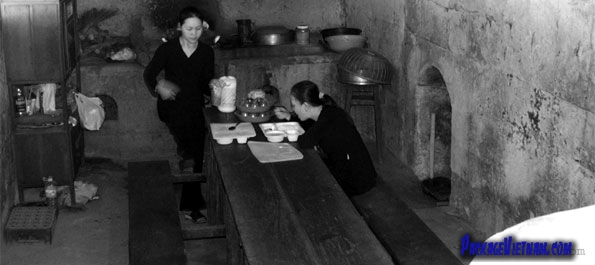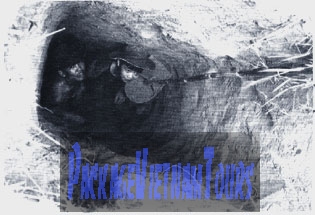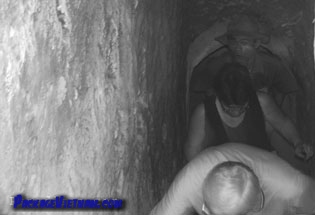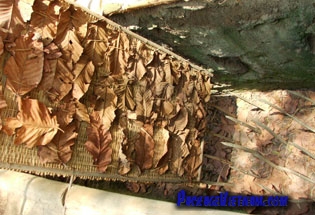
Cu Chi Tunnel
Cu Chi is 65 km (1.5 hour drive) northwest of Ho Chi Minh City. The tunnel network of Cu Chi became legendary in the war for facilitating the local guerrillas to gain victory over the American troops. At its height, these three-levelled tunnels stretched over 250 km. Touring Cu Chi, the travelers would learn more about the war and the resilience of the Vietnamese.

Cu Chi Tunnel Vietnam
Cu Chi Tunnels were not built by any direct order, but by requirements of the fight against the French in 1948. Many patriots who worked secretly in the region and were hidden by local families were caught in the French sweep operations. The locals had to dig secret shelters as hiding places for these patriots in the ground around their houses. Still the French found out and many more were captured hiding in these secret shelters. Gradually they learned to dig tunnels from one shelter to another. The tunnels had exits to the Sai Gon River or to the jungle which helped the patriots escape the French’s operations.
After the French’s pullout of Vietnam, the country was divided into North and South. North Vietnam was turned into the People Republic of Vietnam; South Vietnam was turned into South Vietnam Republic. Vietnam was not re-unified through a general election in 1956 as planned by the Geneva Accord.

Creeping in the Cu Chi Tunnel
In August 1965, with the US Troops arrival in South Vietnam, situations intensified. At this time, South Vietnam was not merely controlled by South Vietnam Republic troops and the American troops. There were many areas occupied by South Vietnam Liberation Front. They were often referred to as the “Liberated Zones”. Many other areas occupied by US troops and South Vietnam Republic’s troops in day time; at night time they were controlled by the guerrilla forces.
Cu Chi Tunnels happened to be close to Sai Gon, to the liberated zone of Binh Phuoc and to route No.1 to
Cambodia. Cu Chi Tunnel was the ending point of the legendary Ho Chi Minh Trails from North Vietnam to South Vietnam traveling through
Laos and Cambodia. Cu Chi had a very strategic position to both sides in the war. Cu Chi was where the military and political headquarters of the South Vietnam Liberation Front were located.
It was not that the US were not aware of the tunnels. In fact, they made several attempts to destroy the underground village. Operation Crimp from 8-Jan through 19-Jan-1966 mobilizing 12,000 infantry combined with aircraft, tank and artillery support were launched in Cu Chi. In the operation water and gas were flushed into the tunnels to force the fighters into the open, the result was 70m of the tunnels was destroyed. On the US side there were 1600 casualties, 77 tanks and armors destroyed, 84 aircrafts downed.

A booby trap at Cu Chi Tunnel
Operation Cedar Fall from 8-Jan-1967 through 29-Jan-1967 with 30,000 troops supported by aircraft, tank, armor and artillery. In Operation Cedar Fall, Tunnel Rats were used. Tunnel Rats were small-sized sappers or soldiers who were selected, equipped and sent into the tunnels to investigate and destroy. Tunnel Rats were sent in 4s. At the end of Cedar Fall the US lost 3,500 men, 130 tanks and armors, 28 fighter aircrafts. In all operations the US also used German dogs to sniff the tunnels but the guerrillas used US shaving cream, cigarettes and other items used by the US troops to confuse the dogs.
Besides tons of defoliants was dumped onto Cu Chi and the Iron Triangle. There was a kind of stimulants that caused the mass growth of wild grass after the rains. The grass had sharp and hard stalk and it was so strong that it actually stopped trees and other kinds of vegetation to grow. All movements on the grass left traces. In the dry season, the grass withered and the US troops set fire to it to burn down the guerrillas. The locals called the grass “American Grass”.
By 1965 this system of tunnels had stretched over 250km in total length. From being a hiding place, it accommodated the local guerrillas to launch direct assaults on the US and South Vietnam Republic troops. The peak of all the assaults launched was in Spring 1968 in which all the most important and the best-protected places in Sai Gon were attacked at the same time.
After the war Cu Chi Tunnels were preserved and opened to the public and to the travelers. The political headquarters of South Vietnam Liberation Front at Ben Duoc was enlarged to accommodate the size of a Westerner. Still climbing these claustrophobic tunnels are not recommended to every tourist. It’s reported that the local tour guides had to dig some tourist getting stuck in the tunnel out.
Travel and tourism
Cu Chi Tunnel is 65km north west of Ho Chi Minh City and it takes 1 hour 30 minutes to travel to Cu Chi from Ho Chi Minh City. The road is in good conditions and the drive offers scenic countryside.
The tour to Cu Chi Tunnel takes half a day from Ho Chi Minh City and can be combined with half a day tour of Ho Chi Minh City or a trip to Tay Ninh Cao Dai Temple. Some travellers can combine the trip to Cu Chi on the way to Cambodia. The trip takes full day and you have to stay overnight in Phnom Penh.
Cu Chi was in the heart of the Iron Triangle in the war and for the war travellers you can combine Cu Chi with other former famous battle fields in the vicinity such as Ben Cat, Lai Khe, Dong Du...
Vietnam Travel Guides
- Activities
- Arts & Entertainment
- Bac Kan
- Bac Lieu
- Bac Ninh
- Battlefields
- Ben Tre
- Buon Ma Thuot
- Ca Mau
- Can Tho
- Cao Bang
- Cat Ba Island
- Chau Doc
- Climate
- Cu Chi Tunnel
- Da Lat
- Da Nang
- Dangers & Annoyances
- Economy
- Embassies & Consulates for Vietnam
- Embassies & Consulates of Vietnam
- Festivals & Events
- Food & Drinks
- Geography
- Gia Lai




 Print
Print 




